|
"O" features a gallery of intensely theatrical characters, rooted in universal
archtypes, that are as home in the water as on land. Tinged with romanticism,
the costumes draw from commedia dell'arte traditions and the age of Baroque -
with a few elements from India and the Arabian Nights thrown in. Inspired by
the courtly fashions of Venice - where East and West met and mingled - the
designs define the characters' silhouettes, which are further accentuated by
the transparency of the materials.
The transparency of the materials was used to suggest nudity. Patterns and
tattoos were added to the sheer fabrics to create a contrasting effect, and
glitter to evoke aquatic animals. Aboard an enormous iron ship between the sky
and the sea, the macabre, disembodied Flayed Ones are tormented souls searching
for the peace that has escaped them for so long. With their ghostly white hair,
they are wounded explorers in a forgotten world. Since digital screen printing
was inaccessible at the time, their muscles were painted on by hand, based on
pictures taken from anatomy books.
Nearly sixty different costumes were developed, and up to ten variations of
these costumes were created for each act. Around 1,200 costume and headpieces
are used in every performance, as each performer has an average of 5 different
looks they wear on stage. Both real and synthetic hair was
used in most of the eight different wig styles. Over sixty wigs had to be
hand-ventilated and tied to outfit the cast members. (Some of them are even
Santa Claus wigs!)
Water provided countless challenges for the Cirque du Soleil costume creators.
"We went through a lengthy testing process for all of the costumes in "O". The
first time we tested our costumes in the Olympic pool here in Montreal, they
exploded!" recalls Yves Fournier, Costume Department Director. "We understood
right away why bathing suits are sewn together differently. We built a little
pool five feet deep in the Montreal studio, and every cutter had a little bucket
in which they soaked their material, to see how it would react. When the
synchronized swimmers started testing the costumes at the Bellagio, we noticed
that all the glowing beads were disappearing, and we didn't know where! One
day, someone opened the pool filter ... and found 3,000 beads!"
The element of water required that the costumes be made of durable materials
that fit like a second skin and dry fast. To accomplish this, a silicone
application was created and used on nearly forty percent of the costumes.
There are also 3 to 5 copies of each of the costume item, as two sets are
used each night - the latex material used does not dry fast enough between
shows. All shoes were constructed of bull hide, which can be worn in water
without shortening the life of the shoe.
Like the costumes, the use of makeup required an extensive testing process.
All makeup used in the show is waterproof. A total of eighty-six different
shades create an unique but unified look and the bright foundations signify
the "light from within the body".
At first glance each of these characters appears to be on their own
journey, and perhaps, in their own time as our play progresses; yet
together they provide a wonderful insight into this strange odyssey.
"The show is about femininity, drama, theatre," says Dominique.
"It deals with love, marriage, birth, death, and rebirth. "O" is the
cycles of life represented through a theatrical experience. "O" is
about splendor, about encountering splendor."



Eugen (Le Vieux)
Stong, but vulnerable, this aging theather manager knows all and provoke us to
see the darkside of «O». He may strike a menacing and enigmatic figure, but don't be
fooled by appearances. The all-knowing old director - this sage, provocative
guardian of the theater - serves as Philemon's indispensable guide and mentor as
he ushers him through the darkness and light of life's endless adventure. His ghostly
orchestrations take us on a timeless journey through different worlds as he makes
his own transformation from dark to white. Everything old becomes new once more.
Guifà (Philemon)
Every story needs a hero - particularly the story of life. He is the young
Sicilian boy who we first meet reading the rules of the theatre to us. But, his
curiousity and quest for adventure ends up transporting him to a magical realm where
all his hopes, fears and dreams come true. He is the willing prisoner in this
kaleidoscopic domain--the witness who is everywhere and every man.
Le Travesti (The Transvestite)
He wears the clothes of a wicked woman; he coos, he hisses,
he murmurs -- his primal cries resound throughout the theater.
Aurora
Aurora is an artist in the world of «O» who has
captured the interest of Guifà. She also turns the
head of Eugen, the theater owner.
Le Joueur d'Orgue de Barbarie
This omnipresent gentle giant goes everywhere Philemon goes. As each mysterious
world emerges, The Organ Grinder is somehow always there to reach out and lend a hand.
La Petite Danseuse
She is a dancer and follows the tune of the Barbary organ,
as she has always done. She dances passionately and with deliberation - everywhere,
all the time, for everyone... but most of all, for herself.
The Voleur Masqué (The Masked Thief)
A masked character is he; with many faces. A clown,
a body guard... one never knows. He plays with fire.
L'Allumé (Man on Fire)
A pyromaniac who enjoys pleasing the crowd.
Le Waiter
The impulsive rubber man can barely control his curiosity. He dances and
gesticulates instinctively, expressing all that he sees and feels.
Les Comètes (The Comets)
Noble. Elegant. Sexy. At times, perhaps, even a little absurd. Like life,
The Comets are as exhilarating as they are unpredictable. Here, they take a few
steps forward; there, a step back. Sometimes slipping sideways, left and then right.
Up and down. They are there when the curtain rises, and again when it falls. Like
all of us, they belong to the universe, to the cosmos.
Les Personnages du théâtre - Les Nus
They are the living memory of all stories told in the theatre,
including: The Beggars from The Three-Penny Opera and
Mother Courage by Bertolt Brecht; The Merchant of Venice
and The Taming of the Shrew by William Shakespeare; La Grosse
Femme by Michel Tremblay; Lady With a Dog by Tchekhov;
Cowboy by Sam Sheppard; Six Characters in Search of an Author
by Pirandello; The Bald Soprano by Ionesco; and many others.
Le Zèbre
Cheerful, affectionate, and utterly harmless. The curious Zebras saunter
around while they watch; they smooch as they strut. When they're alone, they
search for each other. But bring them all together and see how they explode in
to play and mischief.
The Mermaids
A toe, a foot, a leg. More. Suddenly, the world springs to life and the
adventure begins. These creatures from the depths make essential links between
fire, earth, air and water. We wonder with spirits buoyed: what does the future
hold? What will keep us afloat?
Moonhead
Silent, yet powerful, Moonhead symbolizes all fantastical stories that have
taken to the stage throughout time.
The Ballerina
She dances passionately and with deliberation - everywhere, all the time for
everyone... but most of all, for herself.
Les Mariés
Lost and abandoned, the brides are searching for
something - a key to their existance.
The Clowns
With simple, poetic gestures, the White Clown and Blue Clown convey the many
complexities of life. Two unpretentious souls on a search fo answers, Leonid and
Valery provide the light that balances the dark part of humanity. This team,
originally from Russia, has been performing together since the early 1980s and
were both featured in Cirque du Soleil's Alegría.
|
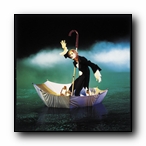
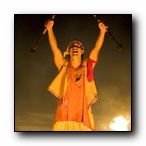
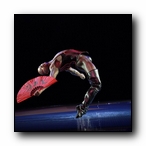
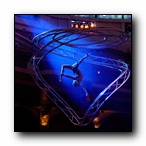
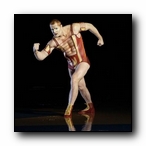
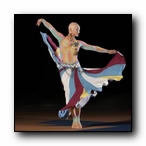
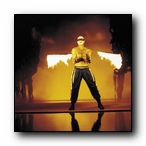
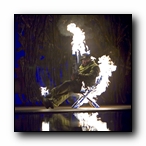
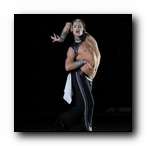
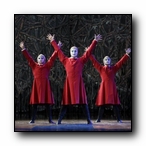
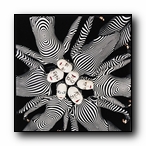
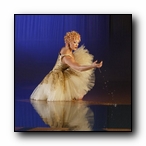
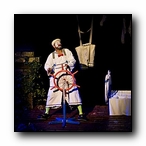
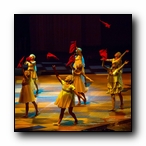
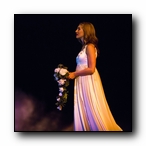
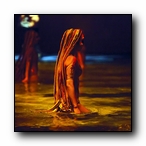
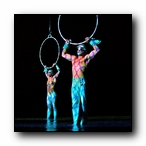
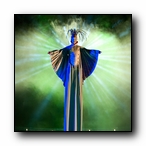
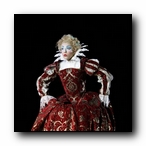
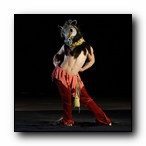
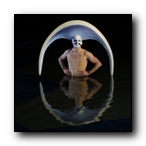
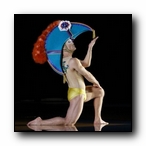
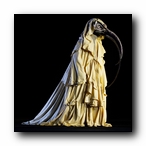
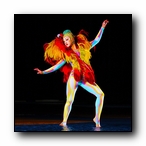
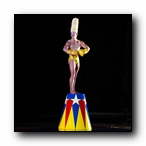
|

![]()






